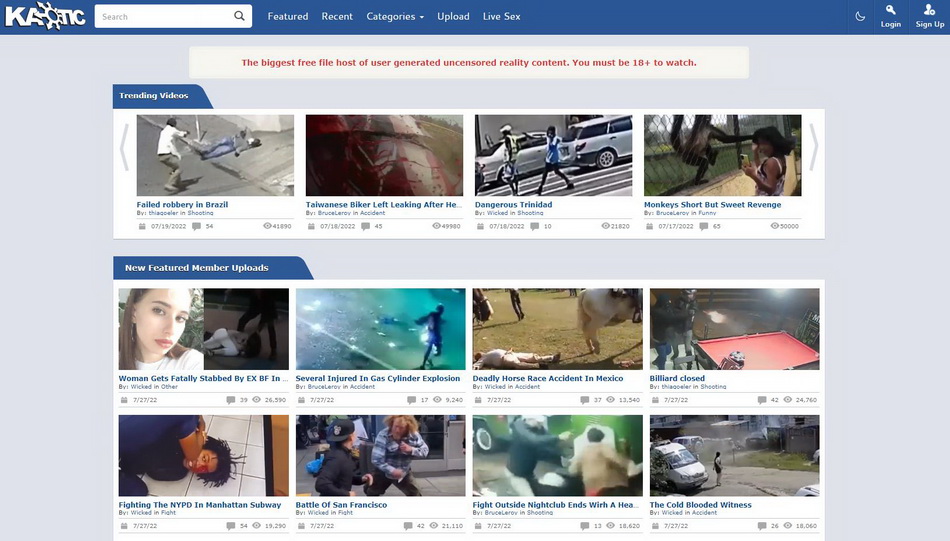Liveleak Alternatives & Chaos: What Happened After The Shutdown?
Can the ephemeral nature of the internet truly erase the darkest corners of its history? The recent shutdown of Liveleak, a platform synonymous with unfiltered, often disturbing content, raises critical questions about the permanence of online material and the lasting impact of sites that traffic in shock value.
For fifteen years, Liveleak stood as a digital repository of the graphic and the taboo. Born in 2006, it positioned itself as a haven for content deemed too extreme for mainstream platforms, a space where the most brutal realities of the world, and sometimes the most gratuitous displays of violence, found a home. Its closure, a quiet end to a controversial era, leaves a void, not just in the digital landscape, but also in the collective memory of the internet. The site, much like its precursor, the infamous Ogrish, served a specific audience, a niche community that sought out content of a particular, and often unsettling, nature. The allure of the forbidden, the morbid fascination with the visceral, and the undeniable power of witnessing events, however disturbing, in real-time were the driving forces behind its enduring, if often uneasy, popularity. Now, the question arises: what becomes of the digital legacy of a platform like Liveleak, and what does its demise signify for the future of online content moderation and the consumption of extreme media?
Liveleak's closure sparked a wave of discussions, not only about the site itself but also about the wider ecosystem of alternative platforms that cater to similar tastes. Users, long accustomed to its offerings, began seeking out alternatives, driving traffic to other websites that embrace explicit and uncensored content. The abruptchaos community, with its 2.4 million subscribers, highlighted the continuing demand for videos that capture moments of unexpected violence and disaster. The appeal of such content, often laced with a darkly humorous edge, speaks to a complex interplay of factors, from a desire for authenticity and raw information to a more primal fascination with the unpredictable nature of human existence. However, there remains a constant reminder that the digital realm's offerings are often fleeting, vulnerable to the tides of change, policy updates, and shifts in consumer behavior.
The founder of Liveleak, Hayden Hewitt, no doubt understood the precarious nature of his creation. His words, though largely unavailable, would likely offer crucial insight into his intentions. The motivations behind creating and maintaining such a platform are complex, ranging from a belief in the importance of unfiltered information and the documentation of historical events to a more cynical embrace of the market that has always welcomed the taboo. Regardless of the underlying principles, the sites presence forced society to confront difficult questions about the boundaries of free speech, the responsibility of online platforms, and the psychological impact of exposure to graphic content. It has raised further debates about the line between information and exploitation. The very nature of a platform such as this, and its eventual demise, serve as reminders of how quickly the online world changes.
The disappearance of Liveleak should be viewed through the lens of the broader internet. Its influence, however, has not vanished. The videos, once available, continue to circulate across the web in various formats, reminding us of the difficulty in controlling digital content, and the inherent challenges associated with managing, censoring, and documenting sensitive material. Its legacy will be evaluated by scholars, digital archivists, and the public who have engaged with the platform in various ways. It underscores how we, as a society, grapple with the darker corners of the internet, how we regulate online content, and the ethics of archiving the most difficult and upsetting aspects of human experience.
The internet's evolution has led to a complex media landscape. The rise and fall of Liveleak underscores the challenges of online content moderation. The discussions around its purpose, its content, and its impact will continue to shape our understanding of the digital world.
| Hayden Hewitt - Founder, Liveleak | ||||||||||||||
|---|---|---|---|---|---|---|---|---|---|---|---|---|---|---|
|
The disappearance of Liveleak is not a unique event. The digital landscape is littered with websites that have come and gone, each one leaving its own trace on the internets vast tapestry. The legacy of Liveleak is complex, representing the intersection of free speech, content moderation, and the human fascination with the extreme. The platform's content will continue to be debated and studied as society grapples with the ever-evolving challenges of the digital age. The demand for such content will persist, leading users to other platforms.
Alternatives to Liveleak, such as deep gore tube, also became part of discussions, especially amongst users seeking content. These 18+ sites feature explicit, uncensored videos that reflect the most disturbing aspects of human experience. They have found a niche that caters to the same audience that Liveleak once served. The existence of these sites serves as a reminder of the continual demand for unfiltered, often sensational, content, highlighting the need for critical analysis.
The abruptchaos community, with its extensive subscriber base, is a testament to the continuing appeal of videos. These videos, capturing chaotic, and often, jarring events, are a direct appeal to the voyeuristic and often morbid curiosity that the internet offers.
Liveleak's shutdown is a pivotal moment. The history of this platform offers insight into how we create, view, and regulate online content. The debates regarding its purpose, content, and impact will continue to shape our understanding of the digital world.

kaotic Make your website better DNS, redirects, mixed content

Was ist die Kaotic Website? Leawo Tutorial Center

www.kaotic urlscan.io